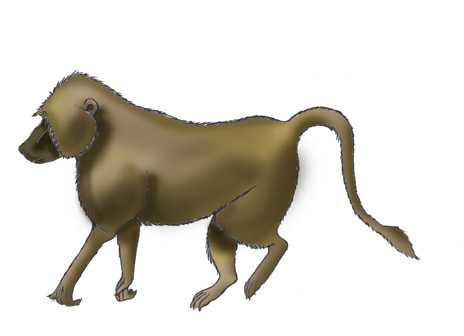

They are found in Africa in Uganda, Kenya and Tanzania.
They live in a variety of habitats including savanna, wooded areas, evergreen forests and farmlands. They need to be near water and trees to escape predators.
Males are much larger than females weighing 50 pounds to the females 30 pounds and measuring 2.5 feet tall to the female’s 2 feet. They have olive-colored fur, with a dark face. Males have a mane of fur.
They live in big groups of more than 4-dozen baboons with a few males, but mostly females and young. As young males mature they leave the troop and join other troops. It takes time for new troops to accept young males and they earn their way into the troop by befriending females in the new troops and “helping” them out by protecting them and their young from predators. Females lead the groups. They communicate with calls of grunts, barks and screams and yawns, shoulder shrugs and lip smacking. They live on the ground mostly, but sleep on cliff or in trees to avoid nocturnal predators. When they have no water they will lick the morning dew from their fur.
They eat grass, berries, roots, fruits, sap, insects, fish, small monkeys and birds. They are omnivores.
They are killed by big cats, hyenas, wild dogs, birds of prey, chimps, crocodiles and humans.
Females are pregnant for 6 months (gestation) and have 1 young. They only have young every other year, as newborns need a lot of care and most of it is done by the female. Females get a bright red, swollen rear end when they are fertile and can mate.
They can live for more than 40 years in the wild. They are not a threatened species.
Kingdom: Animalia
Phylum: Chordata
Subphylum: Vertebrata
Class: Mammalia
Order: Primates
Suborder: Haplorrhini
Family: Cercopithecidae
Subfamily: Cercopithecinae
Genus: Papio
Species: Papio anubis
When you research information you must cite the reference. Citing for websites is different from citing from books, magazines and periodicals. The style of citing shown here is from the MLA Style Citations (Modern Language Association).
When citing a WEBSITE the general format is as follows.
Author Last Name, First Name(s). "Title: Subtitle of Part of Web Page, if appropriate." Title: Subtitle: Section of Page if appropriate. Sponsoring/Publishing Agency, If Given. Additional significant descriptive information. Date of Electronic Publication or other Date, such as Last Updated. Day Month Year of access < URL >.
Amsel, Sheri. "Baboon (Olive)" Exploring Nature Educational Resource ©2005-2024. December 13, 2024
< http://www.exploringnature.org/db/view/Baboon-Olive >

